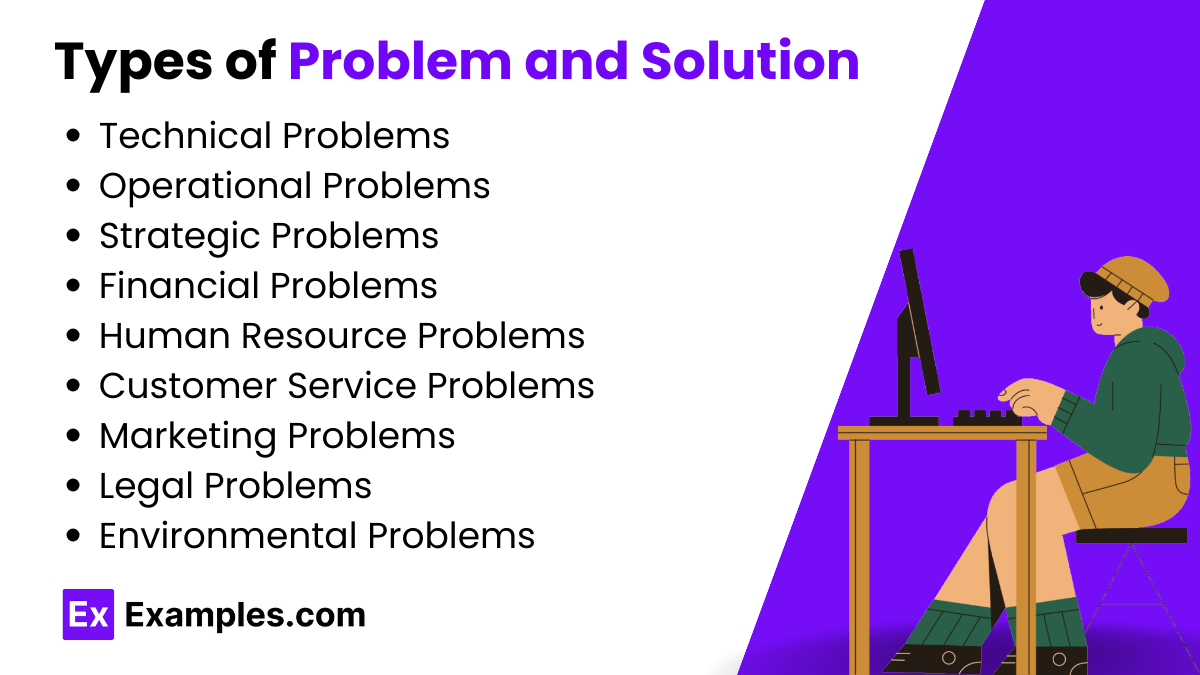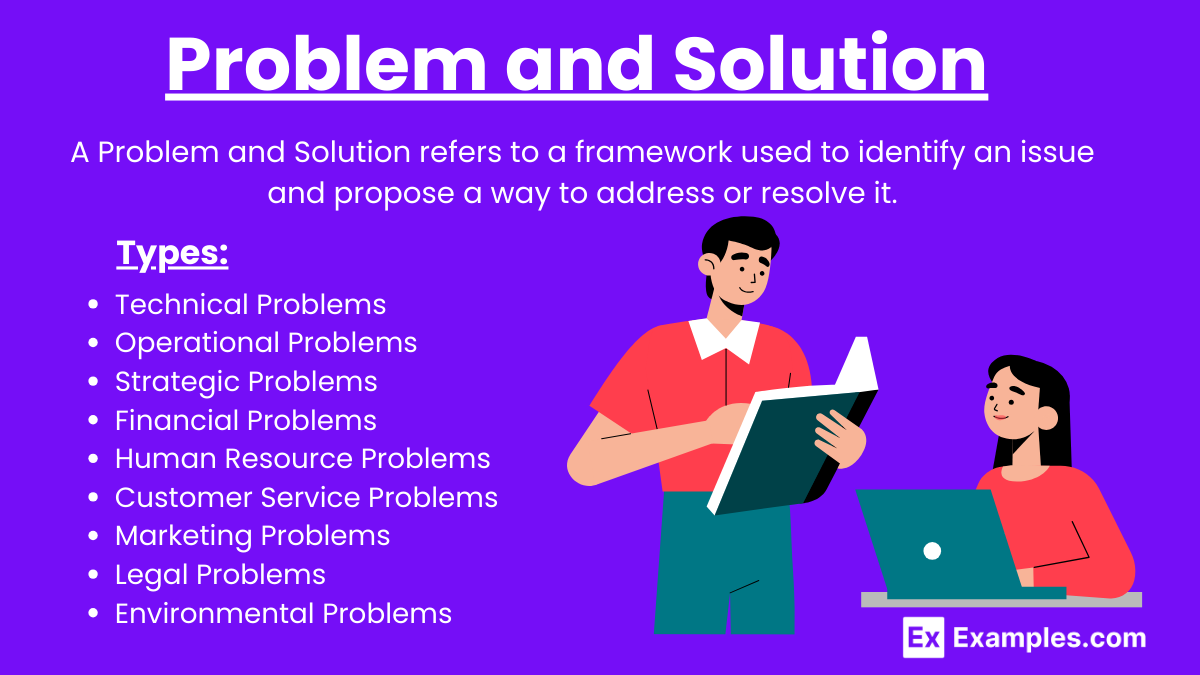20+ Problem and Solution Examples
A problem is a situation, condition, or issue that creates difficulty or presents an obstacle to achieving a desired goal or outcome. Problems can be identified in various contexts, including personal, professional, social, and technical environments. They require resolution to improve circumstances, processes, or performance. A solution is a method, process, or action taken to resolve a problem or address an issue.
Writing a short problem statement can help clearly define the issue at hand. For instance, a business problem solving proposal outlines the steps and strategies needed to tackle specific business challenges. In academic settings, a thesis problem statement articulates the research problem and its significance. Crafting a comprehensive problem statement is essential for setting the stage for finding effective solutions. Addressing a communication problem involves identifying barriers to effective communication and implementing strategies to overcome them.
What is Problem and Solution?
A problem and solution refers to a framework used to identify an issue and propose a way to address or resolve it. This approach involves clearly defining the problem, analyzing its causes and effects, and then developing and implementing strategies or actions to solve it. This method is commonly used in various fields such as business, education, engineering, and everyday life to systematically tackle challenges and improve outcomes.
Examples of Problem and Solution
- Traffic congestion: Build more public transportation options.
- Air pollution: Implement stricter emissions regulations for factories.
- Water scarcity: Develop advanced water recycling systems.
- Deforestation: Promote reforestation and sustainable logging practices.
- Obesity: Increase public awareness about healthy eating and exercise.
- Homelessness: Provide affordable housing and job training programs.
- Cybersecurity threats: Enhance encryption and cybersecurity protocols.
- Plastic waste: Promote the use of biodegradable materials and recycling.
- Climate change: Increase the use of renewable energy sources.
- Unemployment: Offer job retraining and education programs.
- Poor education quality: Invest in teacher training and educational resources.
- Food insecurity: Create community gardens and food banks.
- Income inequality: Implement progressive tax policies and social programs.
- Lack of healthcare access: Expand healthcare coverage and services.
- Energy consumption: Develop and promote energy-efficient technologies.
- Animal extinction: Enforce wildlife protection laws and conservation efforts.
- Ocean pollution: Regulate and reduce plastic disposal and cleanup efforts.
- Mental health issues: Increase mental health resources and support services.
- Traffic accidents: Improve road infrastructure and enforce traffic laws.
- Noise pollution: Implement noise control measures and urban planning strategies.
Types of Problem and Solution

1. Technical Problems
- Description: Issues related to technology, software, or hardware.
- Solutions: Debugging code, replacing faulty hardware, updating software, optimizing network configurations.
2. Operational Problems
- Description: Challenges in day-to-day operations and processes.
- Solutions: Streamlining processes, improving logistics, automating tasks, implementing new operational strategies.
3. Strategic Problems
- Description: Issues affecting the long-term direction and success of an organization.
- Solutions: Conducting market research, revising strategic plans, aligning organizational objectives, adopting new business models.
4. Financial Problems
- Description: Challenges related to the management of finances.
- Solutions: Creating a detailed budget, improving financial planning, cutting unnecessary costs, finding new revenue streams.
5. Human Resource Problems
- Description: Issues involving the workforce and employee management.
- Solutions: Enhancing employee engagement, offering competitive benefits, providing training and development, improving recruitment strategies.
6. Customer Service Problems
- Description: Challenges in delivering satisfactory customer service.
- Solutions: Implementing better customer service protocols, training staff, using customer feedback to improve services, adopting customer relationship management (CRM) systems.
7. Marketing Problems
- Description: Issues related to marketing and advertising strategies.
- Solutions: Developing targeted marketing campaigns, using data analytics, enhancing digital marketing efforts, rebranding.
8. Legal Problems
- Description: Issues involving legal compliance and regulations.
- Solutions: Ensuring compliance with laws, consulting with legal experts, protecting intellectual property, revising contracts.
9. Environmental Problems
- Description: Challenges related to environmental impact and sustainability.
- Solutions: Implementing sustainable practices, reducing waste, using renewable resources, enhancing environmental policies.
Problem and Solution in Research
1. Identifying the Research Problem
- Description: The research problem is a specific issue, difficulty, contradiction, or gap in knowledge that a researcher aims to address.
- Example: Lack of effective treatment for a certain disease, unclear mechanisms behind a social phenomenon, or inefficiencies in a technological process.
2. Formulating the Research Problem
- Description: Clearly defining and articulating the problem in a way that guides the research objectives and questions.
- Example: “What are the underlying factors contributing to the low recovery rate of patients with XYZ disease?”
3. Literature Review
- Description: Conducting a comprehensive review of existing research and theories related to the problem to understand the current state of knowledge.
- Example: Reviewing past studies, articles, and reports on XYZ disease to identify what has been discovered and what gaps remain.
4. Developing Research Questions
- Description: Formulating specific questions that the research aims to answer, derived from the research problem.
- Example: “What treatments have been most effective in improving recovery rates for XYZ disease?” or “How do socioeconomic factors influence recovery rates?”
5. Choosing the Research Methodology
- Description: Selecting appropriate methods and techniques to gather and analyze data that will address the research questions.
- Example: Deciding between qualitative methods (like interviews and focus groups) or quantitative methods (like surveys and experiments).
6. Data Collection
- Description: Gathering data using the chosen methods to obtain information relevant to the research problem.
- Example: Conducting surveys among patients, collecting medical records, or performing laboratory experiments.
7. Data Analysis
- Description: Analyzing the collected data to identify patterns, relationships, and insights that address the research questions.
- Example: Using statistical analysis to determine the effectiveness of different treatments or thematic analysis to identify common themes in interview responses.
8. Presenting the Solution
- Description: Proposing solutions or recommendations based on the findings of the research.
- Example: Recommending a new treatment protocol based on the data showing its higher effectiveness or suggesting policy changes to address identified socioeconomic barriers.
9. Evaluating the Solution
- Description: Assessing the proposed solutions for feasibility, effectiveness, and potential impact.
- Example: Conducting pilot studies to test the new treatment protocol or evaluating the practicality of suggested policy changes.
10. Disseminating the Findings
- Description: Sharing the research findings and proposed solutions with the wider community through publications, presentations, and reports.
- Example: Publishing in academic journals, presenting at conferences, or preparing reports for policymakers and practitioners.
Problem and Solution Synonyms
| Term | Synonyms |
|---|---|
| Problem | Issue, Challenge, Difficulty, Obstacle, Hurdle, Complication, Concern, Dilemma, Predicament, Quandary |
| Solution | Answer, Resolution, Fix, Remedy, Cure, Key, Explanation, Approach, Strategy, Plan |
Uses of Problem and Solution
- Critical Thinking and Analysis: The problem and solution framework helps develop critical thinking and analytical skills. By systematically identifying a problem, analyzing its causes, and brainstorming possible solutions, individuals enhance their ability to think logically and solve complex issues.
- Education and Learning: Teachers and educators use the problem and solution approach to enhance learning experiences. It encourages students to engage with material actively, apply knowledge to real-world scenarios, and develop problem-solving skills essential for academic and personal success.
- Business and Management: In business, identifying problems and devising solutions is crucial for maintaining competitiveness and efficiency. Managers use this framework to address operational issues, improve processes, resolve conflicts, and innovate products and services.
- Engineering and Technology: Engineers and technologists rely on the problem and solution framework to design and develop new products, systems, and technologies. They identify technical challenges, analyze requirements, and create solutions that meet specific needs and constraints.
- Healthcare and Medicine: Healthcare professionals use the problem and solution approach to diagnose and treat medical conditions. By identifying symptoms (problems), they can determine the underlying causes and develop appropriate treatment plans (solutions).
- Policy Making and Public Administration: Policymakers use this framework to address societal issues such as poverty, education, and public health. By understanding the root causes of problems, they can create and implement policies aimed at providing effective solutions.
- Environmental Management: Environmental scientists and managers use the problem and solution approach to address issues like pollution, climate change, and resource depletion. Identifying environmental problems allows them to develop and implement strategies to mitigate negative impacts and promote sustainability.
- Project Management: Project managers use this framework to identify potential risks and issues that could affect project success. They develop risk mitigation plans and solutions to ensure projects are completed on time, within budget, and to the desired quality standards.
What are common problem-solving methods?
Common methods include brainstorming, root cause analysis, trial and error, and the scientific method.
What is root cause analysis?
Root cause analysis identifies the fundamental cause of a problem to address it effectively.
How does brainstorming help in problem-solving?
Brainstorming generates diverse ideas and solutions through collaborative thinking.
What is the scientific method’s role in problem-solving?
The scientific method uses systematic observation, measurement, and experimentation to identify solutions.
How do you prioritize problems?
Prioritize problems based on their urgency, impact, and feasibility of solutions.
What is a problem statement?
A problem statement clearly defines the issue, its context, and its impact.
How can you evaluate potential solutions?
Evaluate solutions by considering their effectiveness, feasibility, and potential consequences.
What is the role of creativity in problem-solving?
Creativity introduces novel and innovative approaches to finding solutions.
How can collaboration aid in solving problems?
Collaboration brings diverse perspectives and expertise, enhancing solution development.
What are the steps in the problem-solving process?
Steps include identifying the problem, analyzing it, generating solutions, implementing solutions, and evaluating outcomes.



